Feast your eyes—and your palate—on these floral fritters that go best with baarish and chai
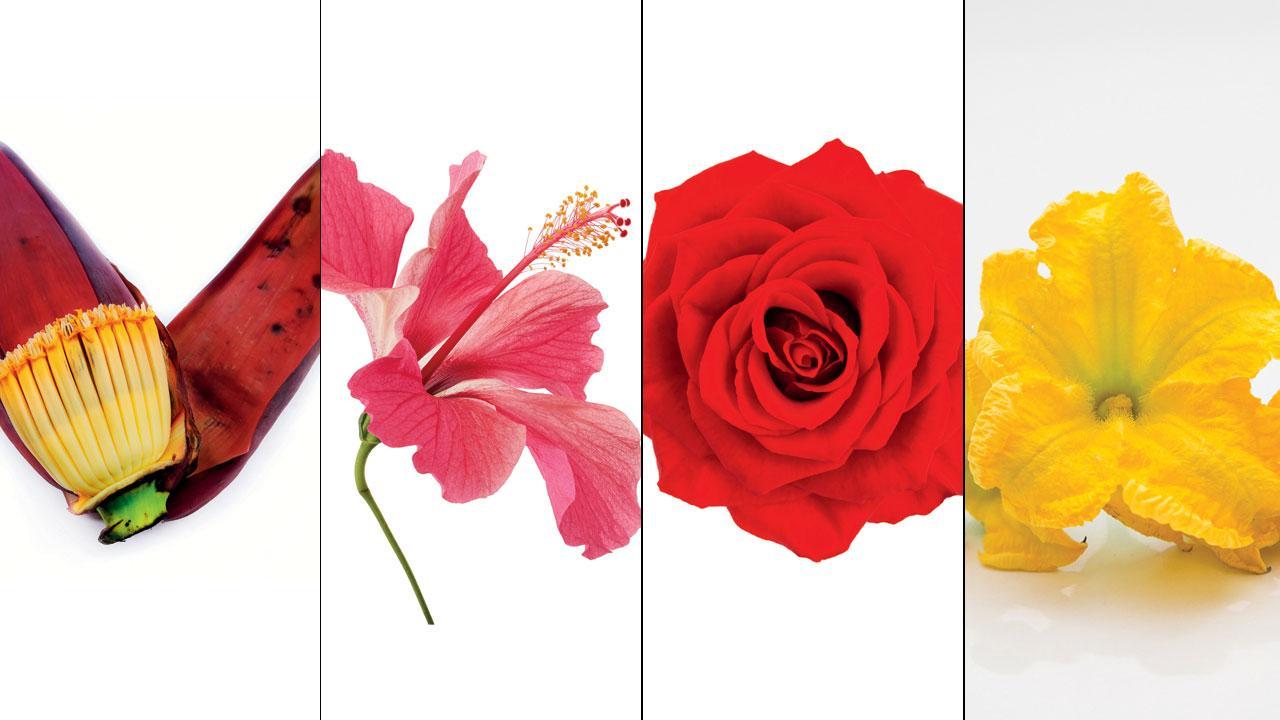
Representation Pic
As a probashi Bengali (Bengali living outside Bengal), one of our fondest childhood memories is gorging on mochar chop (banana blossom croquettes) every time we visited our grandmother in Kolkata, during the monsoons. She made it without fail, sometimes waking up at the crack of dawn so we could eat it for breakfast before the family’s flight out of the city.
ADVERTISEMENT
Banana blossoms are available all year round, but what makes it special is the immense effort that goes into cooking them, making it a literal labour of love. Even years later, biting into the crunchy, steaming goodness of a mochar chop in the monsoon feels like a warm hug from the grandparents.

Anmol Menon
For Chef Anmol Menon, banana flower fritters, made Kerala-style, bring back memories of a simple childhood in Palakkad. “Growing up in a bungalow with a garden and banana plants, we’d fry bananas into pazhampuri or steam them for breakfast. Our neighbour taught us to make vazhapoo vada, a delicious treat perfect for rainy evenings,” he recalls.
The scent of vazhapoo vada takes him back to plucking bananas and blossoms and discovering a passion for food. “The fritters are light, crispy, and earthy with a nutty aroma from gram flour and a hint of bitterness, best paired with a sweet-and-sour dip,” he explains. “As a child, we had them with ketchup, but later found they pair better with date and tamarind chutney.”
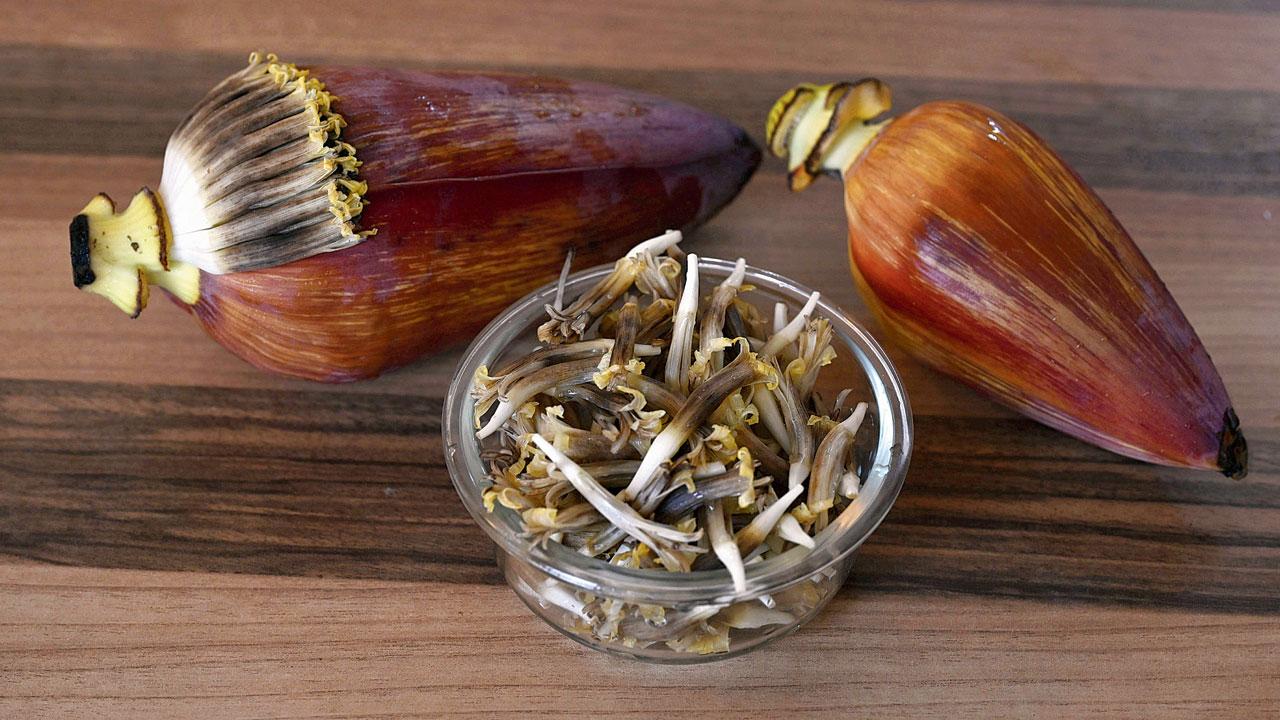
Banana blossom is available all year round, but it’s more commonly used to make sabzi. It’s mostly during the monsoon that cravings for vazhapoo vada strike, says Chef Anmol Menon. Pics/Ashish Raje
Chef Nandita Desai uses flowers to add dimension and variation during Shravan, when some forgo non-vegetarian food. “I use them mostly for fritters,” she says. Cooking flowers is different due to their short life and seasonal availability, requiring delicate handling. Desai grew up eating onion and pumpkin flowers in sabzis; her mother used all parts of a vegetable. During the monsoon season, Desai enjoys sweet rose fritters inspired by her childhood home that had a rose garden. “Roses were integral to my upbringing. My mom used them in various dishes, and my fritters’ recipe is a tribute to those sweet-scented memories,” she says.
Sweet rose fritters
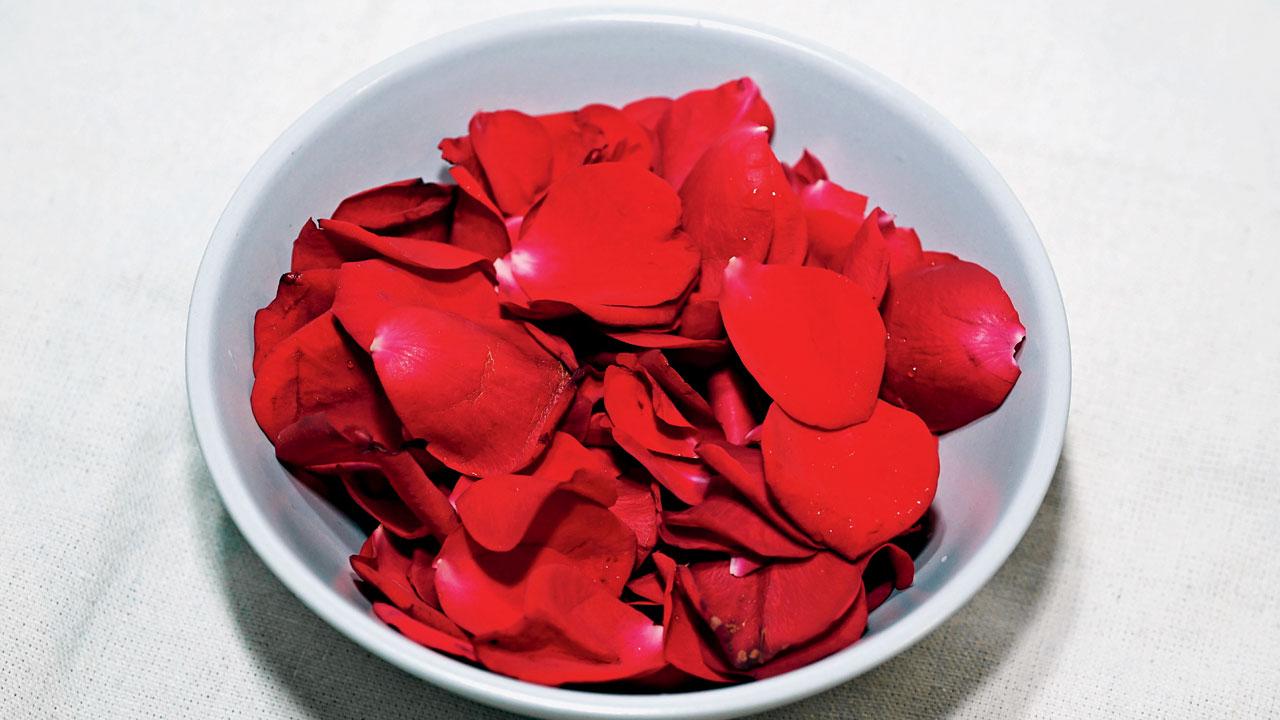
Ingredients
1 bowl of undamaged rose petals
4 tbsp white flour, sifted
1 tsp of rose wine
50 ml drinking soda
A pinch of pink salt
1 tbsp fine castor sugar
Few drops food grade rose water
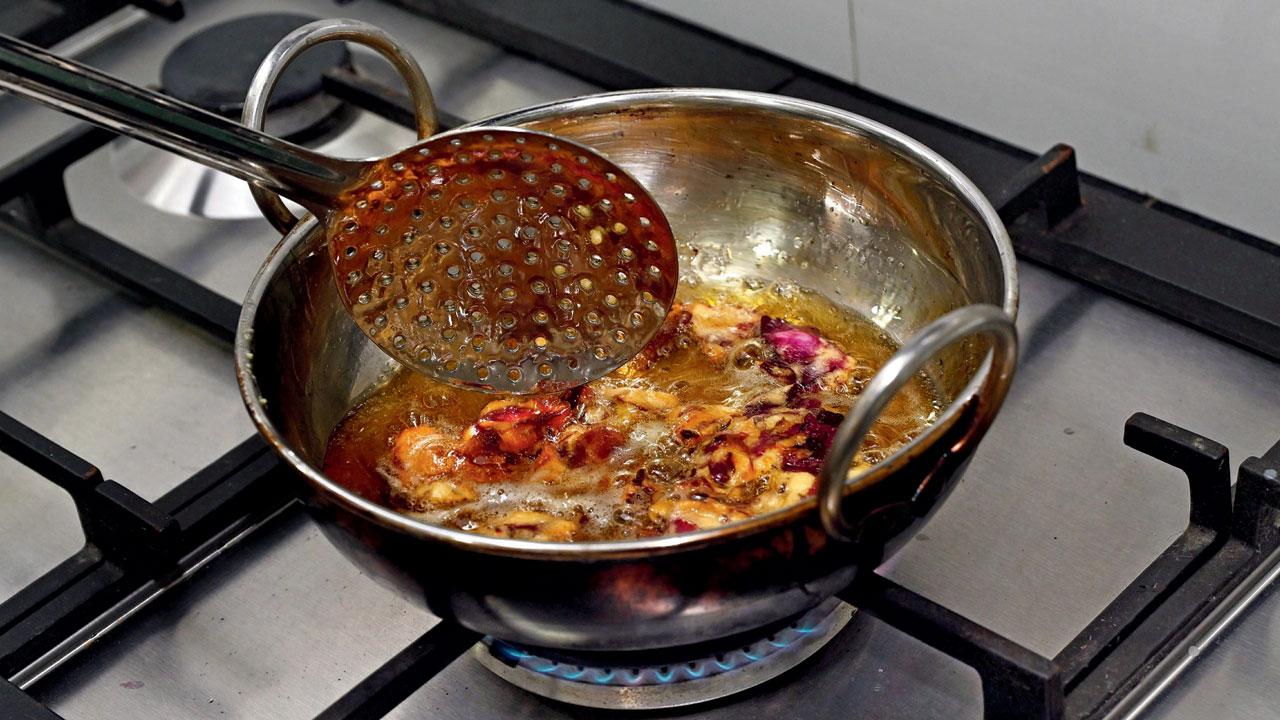
Method
Mix the ingredients. Heat a neutral flavourless oil like grapeseed. Dip the petals, three at a time, in batter and fry on high heat for a few seconds. Place on a paper towel to soak excess oil. Dust with castor sugar, pink salt and fresh rose petals. As a full-plated dessert, serve with pomegranate, cherry compote, and rose cream.
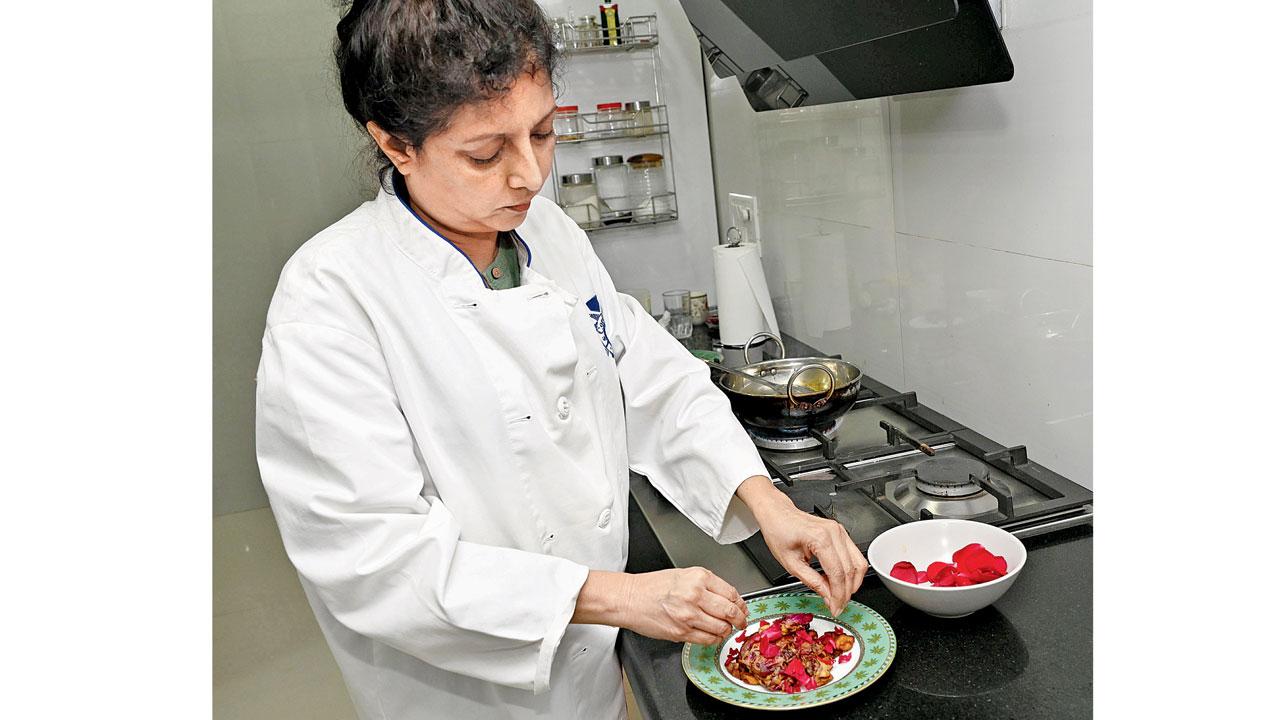
Sweet rose fritters are best enjoyed with a pomegranate and cherry compote and rose cream, says Chef Nandita Desai, who crafted the recipe based on her memories of the rose garden in her childhood home. Pics/Satej Shinde
Cooking with flowers pleases both the eyes and palate. Chef Reetu Uday Kugaji explains, “We eat with our eyes first. Edible flowers enhance flavour and aroma and are nutrient-rich. As a child, my mother made crunchy fritters of pumpkin and moringa blossoms, and marigolds, often challenging me to identify the main ingredient.” During monsoon and Shravan, flower recipes become significant.
“Dried parijat flowers aid digestion, while jasmine and edible roses are also used,” Kugaji says. Her favourites include shapla fuler bora (water lily fritters) from Bengal and hibiscus bhaji (gudhal ke pakode) from Uttarakhand. “Hibiscus, with its cranberry-like sweetness, is perfect for entertaining, best with green coriander chutney and cutting chai.”
Before you embark on your floral culinary journey, know that not all flowers are safe to eat. Kugaji advises against using those from nurseries or roadside stands unless labelled edible due to pesticide risk. Thorough research and caution are key before cooking with flowers.
Gudhal ke pakode
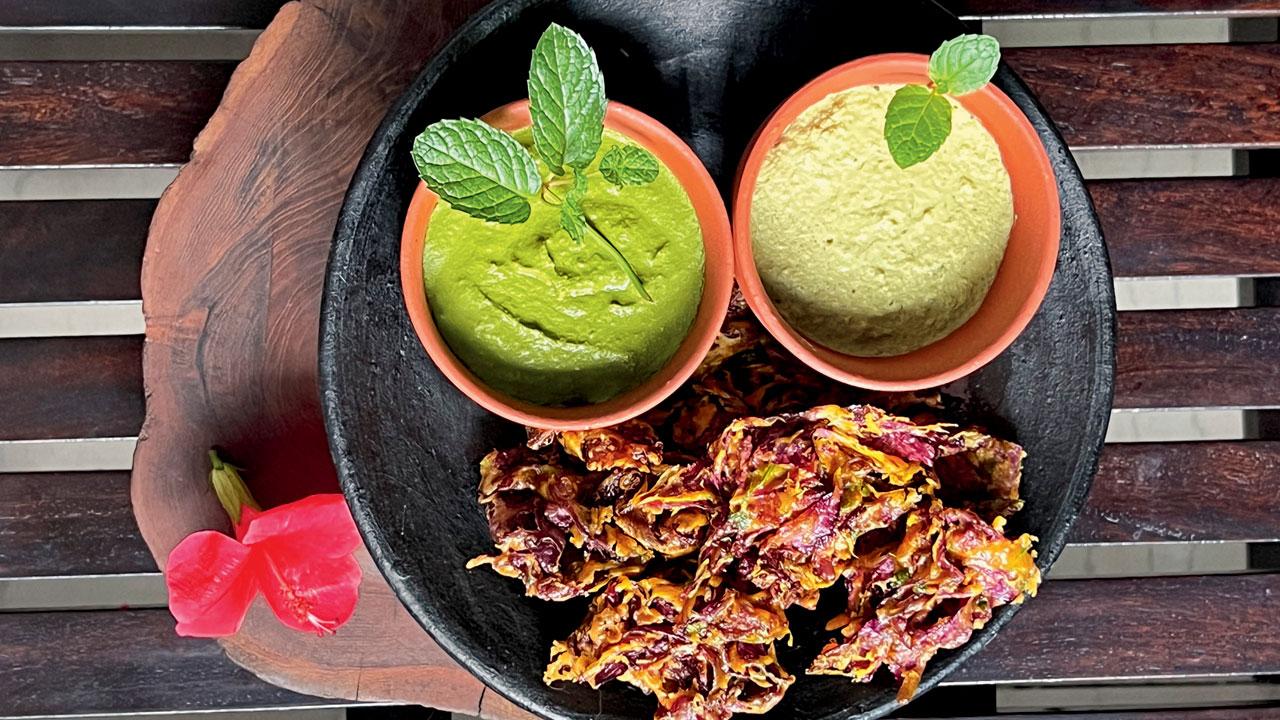
Hibiscus fritters or gudhal ke pakode are a specialty of Uttarakhand, but the flowers are found everywhere, a favourite of Chef Reetu Uday Kugaji
Ingredients
16 hibiscus flowers
Mustard oil for deep-frying
For the batter
3/4 cup Bengal gram Flour
1/4 cup rice flour
1/2 tbsp coriander leaves, finely chopped
1/2 tbsp mint leaves, finely chopped
1 tsp carom seeds
1 tsp red chilli powder
1/2 tsp turmeric powder
1/2 tsp cumin powder
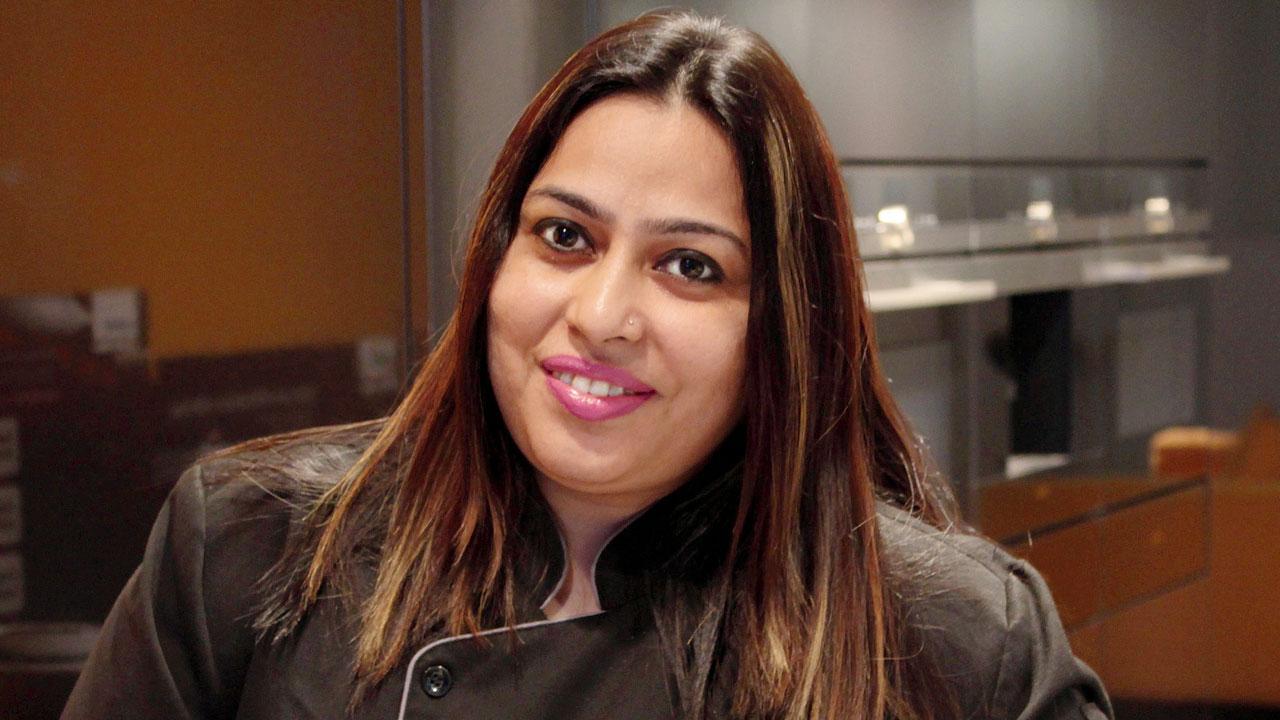
Reetu Uday Kugaji
Method
Wash hibiscus flowers gently, removing sepals and stamens. Place petals on absorbent paper to remove moisture without patting dry. Whisk all batter ingredients except rice flour in a bowl. Then fold in the rice flour, gently and add water slowly till you get a thick batter. Heat oil in a kadhai to medium-hot. Dip petals in batter and fry in small portions until golden and crisp. Drain on a wire mesh to remove excess oil. Serve hot with coriander chutney or your choice of dip.
Vazhapoo vada
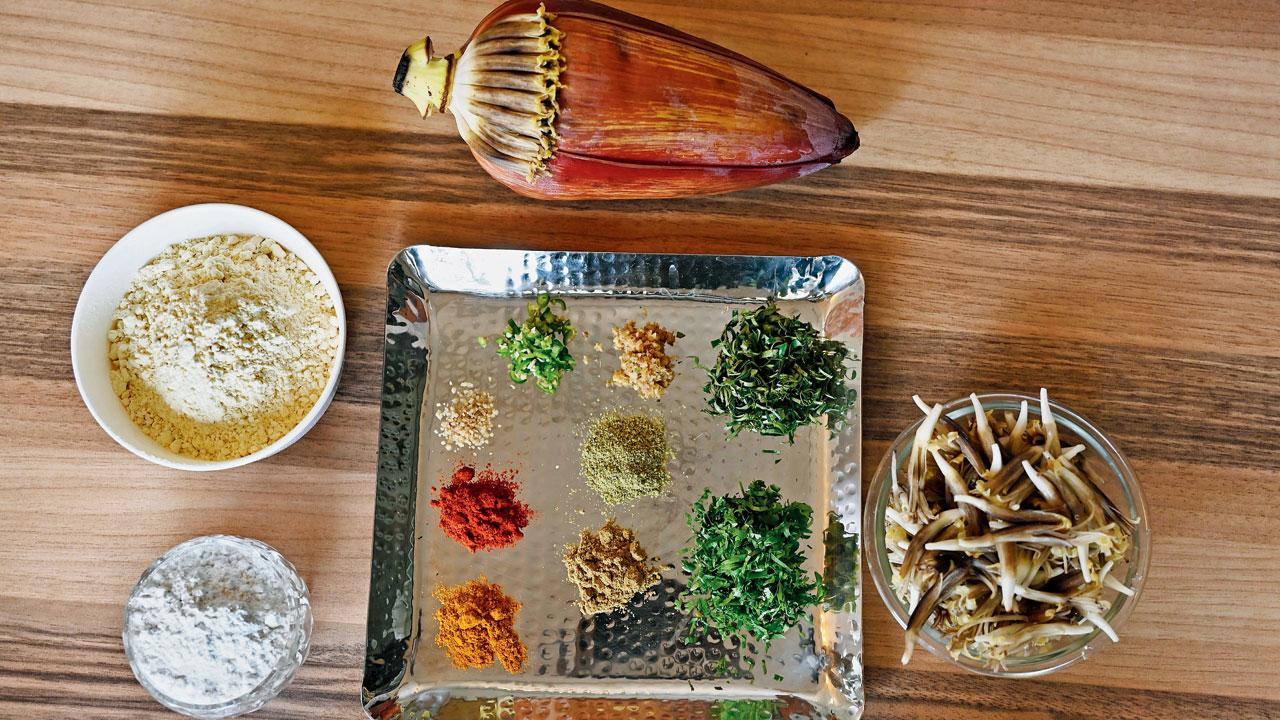
Ingredients
1 large banana flower
Oil for frying
1 lime
For the batter
3/4 cup besan
1/4 cup rice flour
2 tsp red chilli powder (less spicy)
1/4 tsp turmeric
1 tsp saunf powder
1/2 tsp coriander powder
1/2 tsp black pepper powder
Pinch of baking powder (optional)
3 tbsp oil
20 curry leaves (finely chopped)
30 gm fresh coriander (finely chopped)
10 gm ginger (grated)
Salt to taste
Method
Heat oil for frying. Drain the flower buds and place them in a dry bowl. Add all batter ingredients except oil and water, coating the buds evenly. Add plain oil, then 1-2 tbsp of water to form a stiff batter. Fry the coated buds in hot oil, ensuring they don’t clump. Fry on medium-high flame until crispy. Drain on kitchen paper. Serve hot with a sprinkle of chaat masala, fried curry leaves, and ketchup or tamarind chutney.
Preparing the blossom
Rinse banana flower to remove dust and debris. Peel back one large petal to reveal the flower buds (18 to 20 pieces) and pluck them. Remove the stamen (thin stick with black tip) and the small translucent outer layer from each bud. Transfer the buds into a bowl of cool water with the juice of one lime to prevent discolouration. Repeat for all layers of the flower.

Cooked flowers were a regular part of Chef Madhumita Pyne’s Bengali childhood. “Bengalis cook every part of the plant. Pumpkin flowers make tasty fritters called kumro fuler bora. It was a household favourite growing up due to its crunch,” she recalls. Pyne has adapted the recipe for her delivery kitchen based in Andheri. “Traditionally made with besan, it gets soggy during delivery. I developed a new recipe to keep the bora crisp for hours,” she says. Pumpkin flower fritters are famous in Shravan. “For me, Shravan means rain and crunchy fried goodies. Bengalis love khichuri with crispy fried pumpkin flowers,” she says.
Kumro fuler bora

Pumpkin flower fritters or kumro fuler bora is a staple in every Bengali home, especially during the monsoon. Chef Madhumita Pyne’s recipe is a modification of the original, using masoor dal instead of besan to keep the fritters crisp longer
Ingredients
12 pumpkin flowers
1 cup masoor dal
1 tsp ginger paste
1 tsp green chilli paste
1 tbsp nigella seeds
1 tsp turmeric powder
Salt to taste
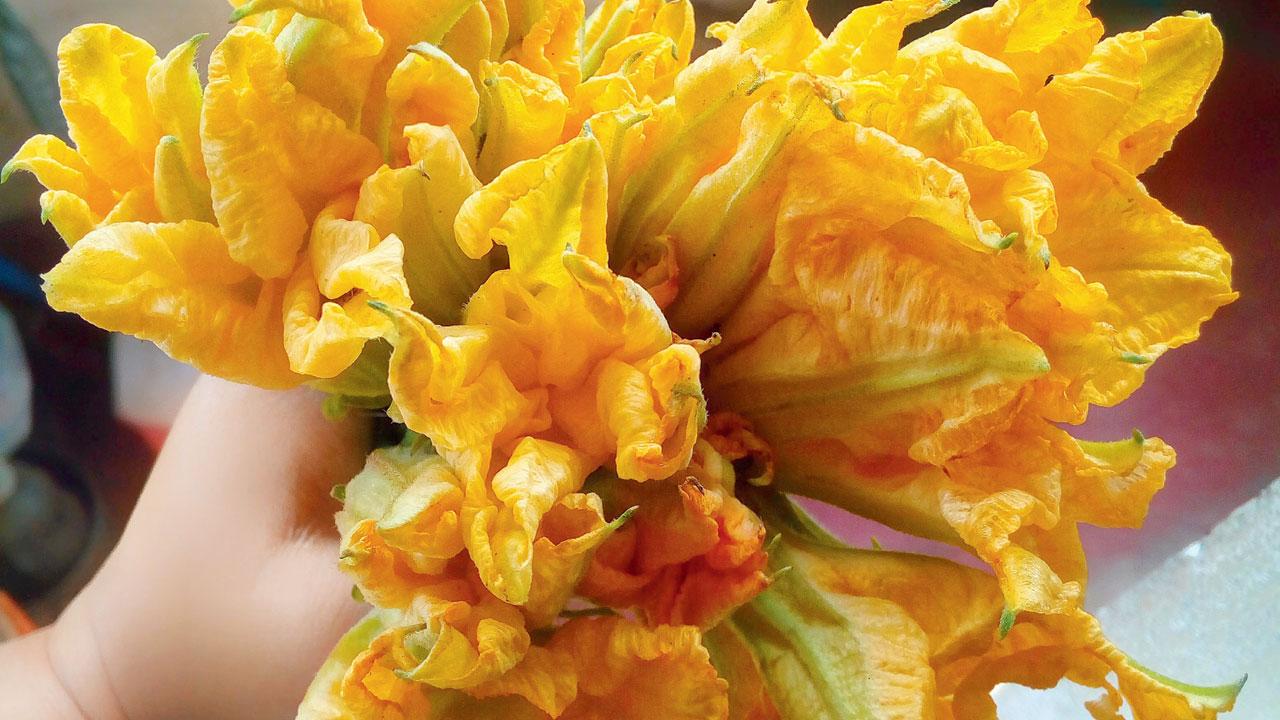
Method
Carefully remove the stem and the stigma, wash the flowers and set them aside to dry. Soak masoor dal for 30 minutes and grind to a coarse paste. Add ginger and green chilli paste, turmeric powder, salt and nigella seeds. Add water, a bit at a time, to make a semi thick batter. Heat oil, dip the flowers in the batter, making sure to cover entirely, and carefully drop them into the hot oil. Fry on medium heat until golden brown. Serve hot.
Mahua fritters, a tribal favourite
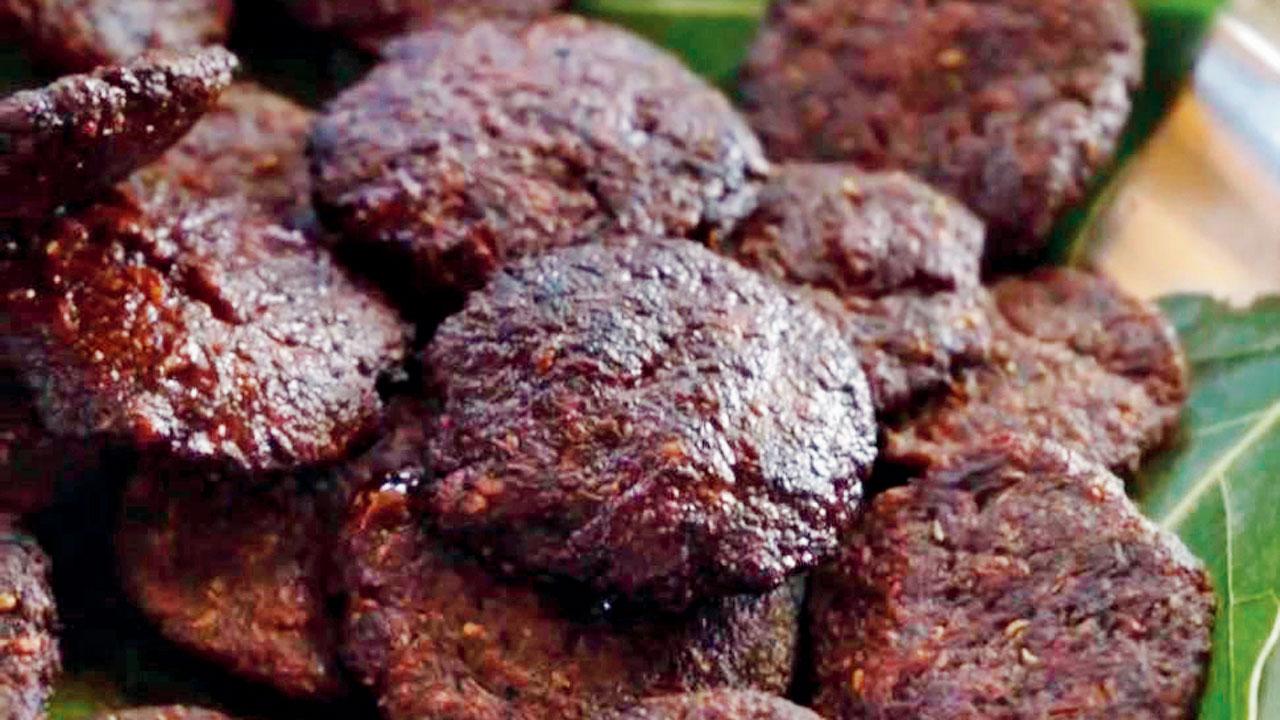
Mahua is also called kalpavriksh, or wish-fulfilling tree because tribal communities use each part of it. The Thakar community in the Sahyadris uses dried flowers to make fritters called mahua che fulachi bhajji. These are also fried in mahua oil, and enjoyed for their crispy texture and tinge of sweetness. This recipe comes from the tribal hamlet Deopada near Karjat, where food culture educator Monks Bouffe holds forest walks and interactions with the Thakars. Soak the dried flowers overnight, mash on a sillbatta, add rice flour, turmeric powder, chilli powder, hand-crushed ajwain seeds, and salt to the paste, and mix gently. Make flat patties using the paste. Warm mahua oil and fry the bhajis until crisp and dark brown. Enjoy with spicy thecha or khurasni chutney.
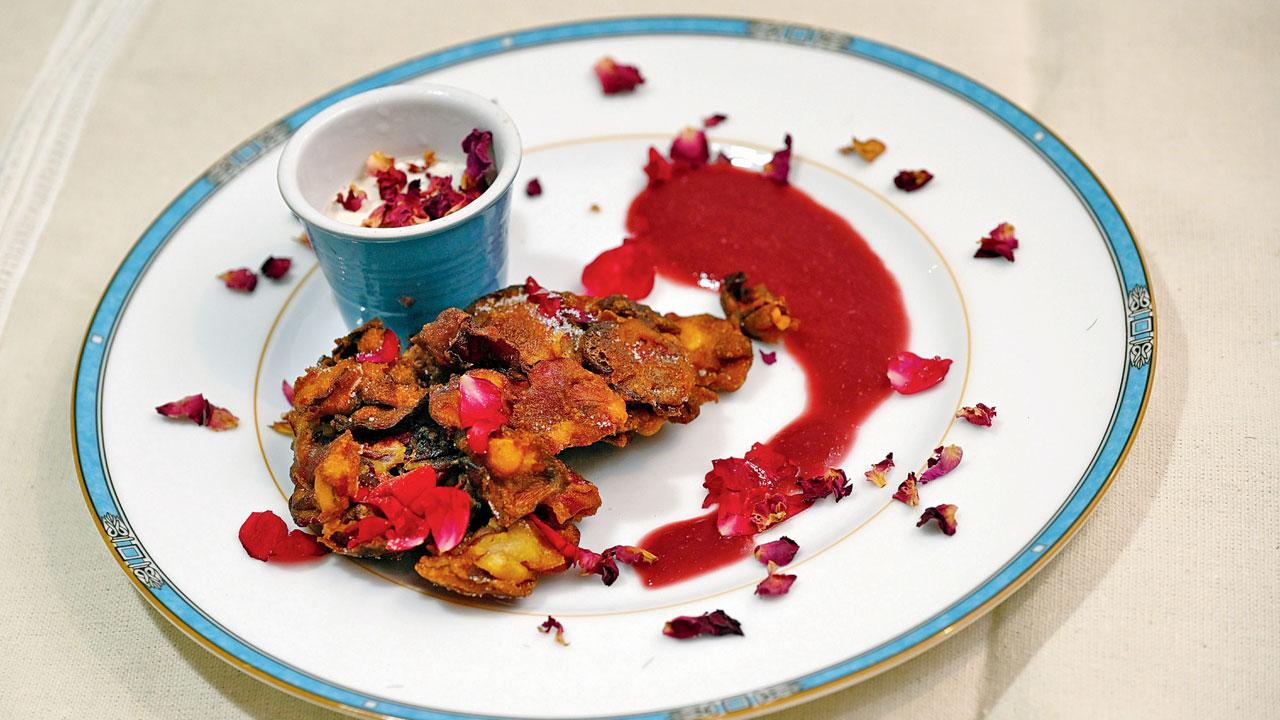
Pomegranate and cherry compote: Juice the pomegranate seeds. Pit the cherries. Cook both on a low flame with a stick of cinnamon. Reduce until semi-solid but not too thick—it should take about 20 minutes. Add castor sugar to taste. Strain. Serve cool. Sprinkle pink salt and a pinch of black pepper before serving.
Rose cream: Gently simmer a packet of fresh cream to a boil. Add castor sugar to taste. Remove from heat. Add dried rose petals, 1/2 of the wine and a squeeze of lemon juice. Put in shot glasses. Cool and freeze for 2 to 3 hours till set.
 Subscribe today by clicking the link and stay updated with the latest news!" Click here!
Subscribe today by clicking the link and stay updated with the latest news!" Click here!







